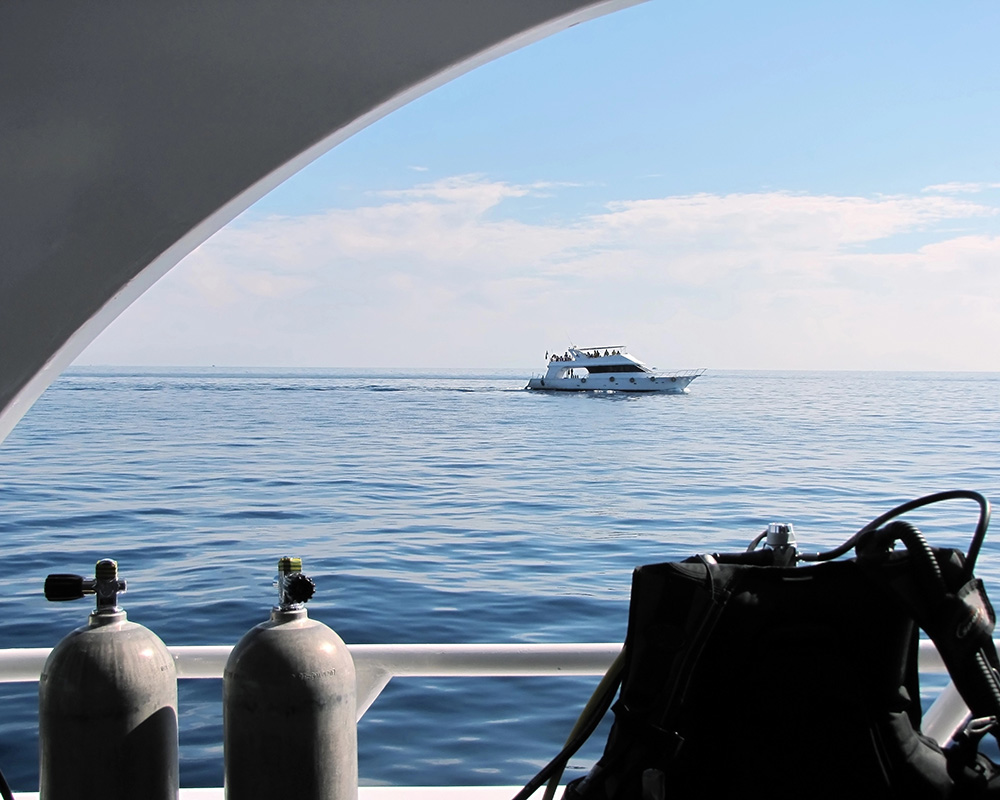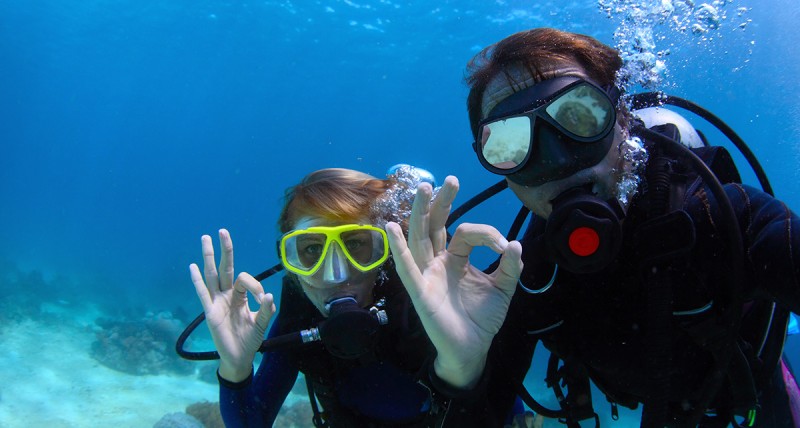1. Why Learn to Dive From Your Own Deck?
Most people picture scuba lessons at a crowded resort beach: a tangle of rental gear, set schedules that can’t flex, and a line of strangers waiting to practice skills. Moving training onto a vessel you already love flips that script completely.
| Shore-Based Course | On-Board Private Course |
|---|---|
| Fixed timetables around shop hours | You decide the lesson blocks and surface-interval activities |
| Gear sized from a rental rack | Equipment fitted, labeled, and stowed exactly where you want it |
| Classmates of unknown experience | Only family and friends—built-in trust and shared goals |
| Walk across hot sand to reach water | Giant stride off the swim platform or roll in from a rib tender |
Whether your boat is a nimble center-console you trailer on weekends or a multi-cabin motor-yacht with crew, the core benefits are identical: privacy, efficiency, and total control of the day’s rhythm.
2. Understanding the Training Path: From Bubble-Blower to Certified Diver
2.1 Entry-Level Certification Basics
All mainstream training agencies (PADI, SDI, SSI, NAUI, RAID) follow a similar progression that blends:
Knowledge Development – modern e-learning modules completed online at your pace.
Confined-Water Skills – mask clearing, buoyancy drills, and emergency procedures in a pool or pool-like setting (your yacht’s shallow aft or a calm lagoon can qualify).
Open-Water Dives – four dives over two days at depths up to 60 ft (18 m) where students repeat core skills under real conditions.
A private instructor simply relocates the classroom to your salon, the confined sessions to sheltered coves, and the open-water dives to nearby reefs or wrecks.
2.2 Intermediate & Specialty Options
Once everyone has an entry card, a floating classroom is ideal for:
Advanced Open Water Diver – five themed dives (navigation, deep, night, etc.) spread over a weekend itinerary.
Nitrox / Enriched Air – a short theory module plus two dives breathing 32–36 % oxygen blends for longer bottom times.
Boat Diver or Diver Propulsion Vehicle (scooter) specialties that align perfectly with life on the water.
Refresher Clinics – for lapsed divers who want to dust off skills before a major trip.
Because training is modular, a mixed group can tackle different specialties simultaneously; the instructor rotates focus while everyone still enjoys the same dive sites.
3. Picking the Right Instructor
3.1 Credentials & Experience
Look for a professional with:
Active teaching status with a recognized agency.
Liability insurance covering instruction on private vessels.
Experience handling courses from small craft and larger yachts.
Emergency Oxygen Provider certification and oxygen kit ownership.
3.2 Compatibility
This is a multiday voyage, so personality fit matters. Arrange a video call to confirm teaching style meshes with your group dynamic.
3.3 Logistics Support
Ask whether the instructor can:
Supply rental gear or broker new equipment purchases and have it waiting on board.
Coordinate tank fills via mobile compressors or local dive shops.
Provide a portable pool or soft-side container for confined-water skills if needed.
Liaise with local authorities for dive permits or marine-park fees.
4. Configuring the Vessel for Training
4.1 Space Planning
| Area | Purpose | Simple Upgrades |
|---|---|---|
| Cockpit / Aft Deck | Equipment setup and pre-dive briefings | Folding table, rubberized matting, personal gear bins |
| Swim Platform | Entry & exit | Removable ladder with deep rungs, slip-resistant deck tape |
| Flybridge or Salon | Theory sessions | 24-inch monitor for e-learning review, charging station for dive computers |
| Forward Locker | Cylinder storage | Plastic cradles or custom foam inserts to prevent roll |
Boats as small as 25 ft often have ample open space once fishing tackle or deck furniture is temporarily shifted.
4.2 Safety Gear Must-Haves
Emergency Oxygen Kit – minimum 15-liter bottle with demand valve and non-rebreather mask.
First-Aid Station – trauma pads, waterproof bandages, seasickness medication.
VHF Radio & Secondary SAT Communicator – for medical consultation and coast-guard coordination.
Surface Marker Buoys (SMBs) & Dive Flag – required by maritime law in most jurisdictions.
Spare-Air / Pony Bottle – optional, but wise for deeper instruction dives.
5. Destinations That Shine for On-Board Training
5.1 Close-to-Home Weekenders
Florida Keys, USA – mooring buoys on Molasses Reef keep anchoring simple; shallow 25 ft sites are ideal for first-time skills.
Southern California’s Channel Islands – calm leeward coves at Santa Cruz or Anacapa offer kelp forests within an hour from marinas.
Balearic Coast, Spain – sheltered Calas (coves) where you can anchor over sandy patches and fin to rocky swim-throughs.
5.2 One-Week Voyages
| Region | Why It Works | Typical Itinerary |
|---|---|---|
| Abacos, Bahamas | Dozens of shallow reefs, crystal visibility, easy navigation | Marsh Harbour → Fowl Cay → Green Turtle Cay → Great Guana Cay |
| Mediterranean Croatia | Calm Adriatic, wrecks at 40–70 ft, medieval harbor towns for evenings | Split → Hvar → Vis → Korčula |
| Whitsunday Islands, Australia | Protected Great Barrier Reef sections, plenty of moorings | Airlie Beach → Hook Island → Whitehaven Bay → Hardy Reef Pontoon |
Smaller boats can buddy up with a local charter for longer crossings, then revert to independent operation at the destination.
6. Balancing Different Vessel Sizes
6.1 The Trailerable or Marina-Based Cruiser (25–40 ft)
Pros: Nimble, lower operating costs, quick to launch.
Challenges: Limited cylinder capacity; plan mid-week fill runs or bring a portable compressor.
Pro Tip: Stow modular weight pouches under forward bunks; they double as ballast for trim.
6.2 The Crewed Motor-Yacht or Sailing Cat (45 ft+)
Pros: Dedicated gear room, freezer for spare O-rings and masks (cold keeps silicone supple), crew assistance with bag handling.
Challenges: Draft limits closer reef access; use the tender to ferry divers to shallow bommies.
Pro Tip: Install a transom-mounted, freshwater rinse shower so regulators get a quick dunk the moment divers climb out.
Both segments benefit equally from a written “dive ops plan” taped near the helm—listing emergency contact numbers, maximum depths, and who’s acting as surface safety watch.
7. Sample Three-Day Private Course Itinerary
| Day | Morning | Afternoon | Evening |
|---|---|---|---|
| 1 | Safety briefing, gear orientation, confined-water Session 1 in sheltered cove | Confined-water Session 2, buoyancy games | Sunset theory review on deck, grill night |
| 2 | Open-Water Dive 1: mask skills at 25 ft reef | Surface-interval snorkeling & lunch | Open-Water Dive 2: compass navigation, 35 ft ridgeline |
| 3 | Open-Water Dive 3: emergency ascent drill at 45 ft | Open-Water Dive 4: fish-ID tour, photography practice | Certification debrief, logbook signing, celebration dinner in harbor |
Because the vessel is your hotel, there’s zero commute time—leaving afternoons free for paddle-boarding, fishing, or simply stretching in the bow sun-pads.
8. Budgeting & Value Strategies
Private instruction certainly costs more than a package resort course, but there’s surprisingly good value when you:
Train as a Group – an instructor can certify up to four students efficiently without adding much overhead.
Purchase Gear Through the Instructor – many pass along pro-level discounts on regulators or BCDs.
Combine Courses – earning Nitrox certification during the same voyage saves a standalone sign-up fee later.
Use Existing Food & Accommodation – you’re already provisioning the boat; lessons rarely add meal costs.
Factor in what you don’t spend on hotel rooms, resort shore dives, or taxis, and the delta narrows quickly.
9. Environmental Stewardship From Your Deck
Eco-Mooring – Use established mooring balls whenever possible to avoid anchor scars.
Gray-Water Protocols – Pump out before reaching sensitive reef zones.
Reef-Safe Sun Protection – Switch to zinc-based lotions and long-sleeve rash guards.
Citizen Science – Log fish sightings for Reef Check or CoralWatch; some instructors are certified survey trainers.
Small everyday habits stack into meaningful reef protection, which enhances the sites you’ll revisit year after year.
10. Frequently Asked Questions
| Question | Answer |
|---|---|
| Do I need special insurance? | Many yacht and boat policies already cover watersports; confirm that scuba instruction is included or add a rider. |
| What about weather delays? | A private course schedule flexes. Skills can shift to the next calm window, and e-learning continues inside the cabin. |
| How many tanks do we need? | Two per diver per day is comfortable. Compressors become worthwhile for groups of four diving more than three days. |
| Can children participate? | Minimum age varies by agency (usually 10). A private setting can be gentler for junior divers, provided water skills and maturity are assessed honestly. |
11. Two Mini-Case Studies
11.1 The “Weekender” Cruiser Crew
Boat: 32-ft express with twin outboards, based in Charleston, SC
Crew: A couple and their college-age son
Plan: Three consecutive Saturday–Sunday trips to nearby artificial reefs. Compressed air fills at a marina halfway between dives.
Outcome: Family certified without taking PTO; son later used the card to join a research expedition.
11.2 The “Liveaboard-Lite” Catamaran Group
Boat: 48-ft sailing cat chartered in the BVIs, skipper and cook hired separately
Crew: Two couples, plus each couple’s teenage child
Plan: Seven-night itinerary—mornings for training dives, afternoons for island hikes.
Outcome: Six new Advanced Open Water certifications, kids logged night dives under a full moon, parents chilled Champagne at 50 ft to toast at the surface stop.
12. Crafting Your Own Floating Dive Academy: Step-By-Step
Define Goals – entry certification, specialty, or refresher? Knowing this shapes site selection and supply lists.
Choose Dates & Crew Size – check local marine calendars for regattas or fishing tournaments that clog marinas.
Hire the Instructor Early – prime professionals book out months ahead during high season.
Arrange Gear & Fills – decide on onboard compressor, dockside fills, or cylinder swaps with a local shop.
Draft a Safety Plan – include roles (surface watch, first-aid lead), radio channels, nearest chamber.
Provision Smartly – high-calorie snacks and electrolyte drinks combat post-dive fatigue.
Plan Non-Dive Fun – paddle boards, kayaks, beach BBQ kits keep non-divers engaged.
Log, Celebrate, Repeat – digital logbooks sync via Wi-Fi; a framed group photo becomes a wheelhouse conversation piece.
Conclusion: Where Seamless Instruction Meets Uncrowded Adventure
Turning your boat into a mobile dive school eliminates the two biggest barriers to certification: time crunch and lack of personal attention. Instead of fitting your life around a dive shop’s clock, the ocean becomes an extension of your living room—complete with the people you trust most and an instructor focused solely on your group’s progress.
Imagine surfacing beside your own transom ladder, hearing only gulls and gentle engines idling, then sharing fresh-cut fruit while flipping through photos of a first successful hover. That blend of autonomy, comfort, and shared triumph is hard to beat—and entirely within reach once you invite a professional aboard.
Ready to plot the first course? Reach out for a complimentary vessel-readiness consultation. Together we’ll chart safe routes, select the right gear, and schedule a training plan that meshes seamlessly with your cruising calendar. Your boat already takes you to beautiful places; adding scuba opens a whole new dimension just below the surface. Dive in, and let the adventure begin.




